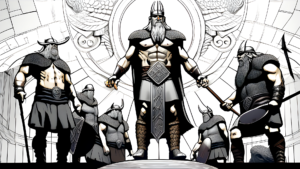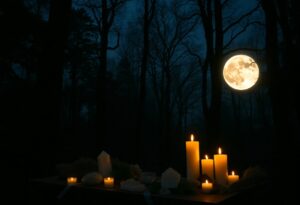
Gods of the North
Over centuries, the ancient Norse people worshiped a pantheon of powerful gods and goddesses, each representing different aspects of life, nature, and the cosmos. These deities played a significant role in the daily lives of the Norse people, with rituals and sacrifices offered to gain favor and protection. In this article, we will research into the fascinating world of the Norse gods and goddesses, exploring what each one represented and the rituals involved in their worship. Join us on a journey through the myths and legends of the Gods of the North.
Key Takeaways:
- The Gods of the North were revered by the ancient Norse people, each representing different aspects of life and nature.
- Rituals were performed to honor and appease the gods and goddesses, often involving sacrifices and prayers.
- Thor, Odin, Freyja, and Loki were some of the most prominent deities worshiped by the Norse people, each playing a significant role in their daily lives.
- The Gods of the North were believed to interact with the people through various signs and omens, influencing events and playing a role in their destinies.
- The rich mythology surrounding The Gods of the North continues to captivate people to this day, inspiring art, literature, and popular culture.
The Pantheon of the North
Odin, The Allfather
Some of the most revered gods and goddesses in Norse mythology belong to the pantheon of the gods of the North. Odin, known as the Allfather, is the chief among them. He represents war, wisdom, and poetry, and is often depicted as a wise old man with one eye. Rituals in honor of Odin would often involve sacrifices and offerings at sacred sites such as burial mounds or runestones.
Thor: The Norse God of Thunder
Thor, a central figure in Norse mythology, is renowned as the god of thunder, the sky, and agriculture. He is depicted as a formidable warrior with a red beard and immense strength, often seen as a protector of both gods and humans. Thor’s name itself is derived from the Germanic word for thunder, and his legendary hammer, Mjöllnir, is said to be the embodiment of thunderbolts.
Thor’s Family and Role
Thor is the son of Odin, the chief of the gods, and Jord, the personification of Earth. He is married to Sif, a fertility goddess, which further emphasizes his connection to agriculture and the protection of the human realm, Midgard. As a defender of Asgard and Midgard, Thor is primarily associated with protection through his martial prowess, particularly in slaying giants and other formidable foes.
Mjöllnir: The Hammer of Thor
Mjöllnir, Thor’s hammer, is not only his primary weapon but also a divine instrument used to bless various ceremonies, including marriages, births, and funerals. The hammer symbolizes both the destructive power of the storm and protection against evil. It was created by dwarfs and is characterized by its short handle, a result of Loki’s interference during its forging. The hammer was so central to Thor’s identity that it was worn as an amulet by Viking Age people, reflecting their faith in Thor and serving as a counter-symbol to the Christian cross.
Thor’s Battles and Enemies
Among Thor’s chief enemies was the world serpent Jörmungand, a symbol of evil. Their final battle at Ragnarok, the end of the world, results in their mutual destruction. Thor’s confrontations with giants and the Midgard Serpent are recurring themes in the myths, showcasing his role as a protector and his unyielding strength.
Thor’s Attributes and Worship
Thor’s attributes include his hammer, a belt named Megingjörð, and iron gloves named Járngreipr, which aid him in wielding Mjöllnir. He is often depicted as straightforward and action-oriented, preferring direct confrontation over strategy. Thor’s popularity was not limited to warriors; he was venerated across all social classes for his reliability and protective nature. Temples dedicated to Thor were established, although they were later destroyed with the rise of Christianity.
Thor in the Viking Age and Beyond
During the Viking Age, Thor’s cult reached its zenith. He was invoked in various aspects of life, from sealing business contracts to ensuring victory in battle. His rivalry with Christ during the Christianization of Scandinavia is evident in the numerous Thor’s hammer amulets dating from this period of religious contention.
Thor in Modern Culture
Thor’s legacy continues in modern culture, including his portrayal in the Marvel Universe, where he is depicted as a mighty warrior, albeit less harsh than his mythological counterpart. The modern Pagan religion of Heathenry also identifies with symbols from pre-Christian Germanic beliefs, including Mjöllnir.
In conclusion, Thor stands as a symbol of strength, protection, and the human connection to the natural world. His stories and attributes have transcended time, maintaining a presence in both historical reverence and contemporary media.
Freyja, The Goddess of Love
Some of the most beloved deities of Norse mythology are the goddesses, and Freyja, the goddess of love, stands out among them. She embodies love, beauty, and fertility, and is often depicted as a powerful and independent woman. Offerings of flowers and jewelry were made to Freyja in hopes of gaining her favor in matters of the heart.
Love was a central theme in the worship of Freyja, and many rituals involving her were centered around matters of love and relationships. Followers would seek her guidance and blessings in matters of romance, marriage, and fertility, believing that her influence could bring joy and fulfillment to their lives.

Rituals and Worship of the Gods of the North
Sacrifices and Offerings
Clearly, a significant aspect of worshiping the Gods of the North involved sacrifices and offerings. These acts were meant to honor the deities and seek their favor in various aspects of life. Animal sacrifices were common, with livestock such as cattle, sheep, and horses being offered to the gods. In addition to animals, other offerings like food, drink, and valuable items were presented at rituals and altars.
Seasonal Festivities and Honoring
Rituals during seasonal festivities played a crucial role in the worship of the Norse gods. These celebrations were held to honor specific deities associated with each season, such as Freyr for fertility and harvest. People would gather to partake in feasting, drinking, and storytelling to commemorate the gods and their influence over nature and human life. Ceremonies during these festivities were elaborate and included songs, dances, and ceremonial rituals.
Plus, the Norse people had a deep connection with nature, and many of their rituals were based on the changing seasons and natural cycles. By aligning their worship practices with the rhythms of nature, they believed they could maintain harmony with the gods and the natural world.
The Interaction Between the Gods of the North and Humanity
Divine Interventions in Norse Tales
Despite their often distant and enigmatic nature, the Gods of the North frequently intervened in the lives of humanity in the tales of Norse mythology. Whether it was offering guidance, bestowing blessings, or even causing mischief, these deities played a significant role in shaping the destinies of the mortals they watched over.
Lessons from the Legends
For those who worshiped the Gods of the North, the stories and legends surrounding these powerful beings provided valuable lessons and insights into the complexities of life. These tales were not just entertaining narratives but were also meant to impart wisdom, teach morality, and emphasize the importance of honor, courage, and loyalty.
From the epic sagas of Odin, the wise Allfather, sacrificing his eye for knowledge, to the tragic tale of Loki’s deceit leading to Ragnarok, the end of the world, each myth carried a profound message or moral that resonated with the Norse people.
The Enduring Legacy of the Gods of the North
Norse Gods in Modern Culture
After examining the fascinating history and significance of the Norse gods in ancient times, it is evident that their influence continues to resonate in modern culture. From Marvel’s popular Thor movies to the incorporation of Norse mythology into various aspects of art, literature, and even fashion, the gods of the north have left an indelible mark on contemporary society.
Conclusion: Reflecting on the Influence of Norse Deities
Legacy: The Gods of the North have captivated countless individuals throughout history, inspiring awe, fear, and reverence. To research deeper into the world of these captivating deities, consider exploring Brian Branston’s comprehensive book, Gods of the North: Branston, Brian: 9780500271773.
Culture: By reflecting on the enduring influence of the Norse deities, we gain a deeper understanding of the rich tapestry of mythology that has shaped societies for centuries. Dive into the mythology and explore the intricate world of the gods of the north for a truly enlightening experience.
FAQ
Q: Who were ‘The Gods of the North’?
A: The Gods of the North are the ancient deities worshipped by the Norse people, including Odin, Thor, Freya, and Loki.
Q: What did each of ‘The Gods of the North’ represent?
A: Odin represented wisdom, Thor represented strength and thunder, Freya represented love and fertility, and Loki represented trickery and chaos.
Q: What rituals were involved in worshipping ‘The Gods of the North’?
A: Rituals included offerings of food, drink, and valuable items, as well as ceremonies such as blót (sacrificial feasts) and Sumbel (ritual toasting).
Q: How did ‘The Gods of the North’ interact with the people?
A: The Gods of the North were believed to influence various aspects of life, such as war, harvests, and weather. People would pray to them for protection, guidance, and blessings.
Q: What significance did ‘The Gods of the North’ have in Norse society?
A: The Gods of the North played a central role in Norse mythology, shaping the beliefs, values, and traditions of the people. They were seen as powerful beings to be revered and appeased.






